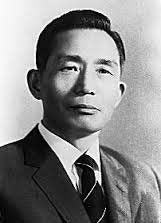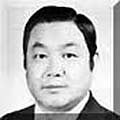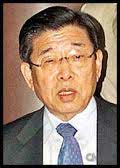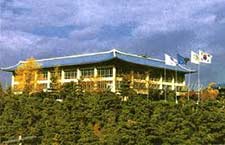Martial Arts: Korean Arts: Taekwondo
Storming the Fortress: A History of Taekwondo
Part Five (Continued):Political Forces Shape the Evolution of Karate Into South Korea's National Sport
By Eric Madis
The May 16, 1961 coup d’etat in the Republic Of Korea resulted in a military government with General Park Chung-hee (1917-1979) as the acting President. As General Choi Hong-hi later explained, he supported the coup because he had been advised that (Army Chief of Staff) General Chang Do-young was the leader of the coup. Choi later found out that Park and his supporters had used Chang’s name, as well as Park’s extensive network in the military from his attendance at the Japanese Military Academy, the Manchurian Officers School and the Korean Military Academy, to gather support for the coup. Park then accused Chang of plotting against him and had him arrested in July, forcing Chang to flee to the US. Choi explained that, since Park had promised he would resign the presidency and return to the Army once order was restored, he advised Park to keep that promise (Kimm, 2000). However, Park planned to occupy the presidency permanently, and “was fiercely opposed by those of democratic persuasion” (Ha & Mangan, 234). Choi said, “I knew Park, Chung-hee better than anyone else. I did not believe that Park was qualified to be president and I never thought that Park was a legitimate president” (Kimm, 2000). As a result of Choi’s advice to Park, he was forced to retire from the Army and then appointed as Ambassador to Malaysia in 1962 to get him out of the country (Kimm, 2000). This took place while Choi was still the leader of the movement to unify Korean karate into taekwondo.
 |
Park Chung-hee |
In 1962, Choi organized a meeting of kwan (Korean: “institute”) representatives and the Korean Sports Union, but had to leave the meeting before it was adjourned. In Choi’s absence the participants agreed on the term taesoodo, a compromise between Choi’s taekwondo and the older tangsoodo, renamed the organization the Korean Taesoodo Association and elected Choi as President (Kang & Lee, Chapter 2, Section 6; Kimm, 2000). When Choi received this news, he declined the presidency because of his commitment to the term taekwondo. After accepting the position in 1965, Choi was successful in changing the name to the Korean Taekwondo Association (Kimm, 2000).
While Choi was Ambassador to Malaysia, he continued to work on developing taekwondo as a separate art from karate, employing technical assistance from some Chungdohwe and Odokwan masters, particularly Nam, Tae-hi and Han Cha-kyo, but including Woo Jong-lim, Kim Bok-man, Choi Chang-keun, Park Jung-soo and others (Graham Noble Interviews, 2005-2010). He traveled throughout Asia, promoting taekwondo and using elite taekwondo practitioners to demonstrate the art’s superiority to karate and Chinese chuan-fa (Chinese: “fist art”/kung fu)(Kimm, 2000). By 1965 Choi, with technical advice from Nam and others, finished designing the tul (Korean “patterns”, also hyung, poomsae; Japanese: kata) known specifically as the Chang-hon forms, which were modeled closely on sequences from Shotokan karate forms (Thomas, 1988). Although these new forms retained traditional karate movements and techniques, they were given names based on Korean historical and nationalistic themes, and this practice has continued with the modern World Taekwondo Federation (WTF) forms (Yates, 1988; WTF, 2013b).
 |
Nam Tae-hi |
On March 22, 1966, Choi established the International Taekwondo Federation (ITF). At this point, Choi’s influence had diminished considerably in the ROK; he had been forced to resign the presidency of the KTA, and yet still had a large and growing international following (Burdick, 1997/1999; Gillis, 78-79; Kimm, 2000). By the mid-1960s, a new generation of tangsoodo and taekwondo leaders were emerging, willing to unite and becoming increasingly impatient with the obstinate tendencies of Choi, Hong-hi and Hwang Kee (Kang & Lee, 1999: Chapter 2, Sections 9 & 10).
ROK President Park Chung-hee is viewed by some as a great leader who transformed South Korea from an impoverished country into a modern, economic miracle, and by some as a military dictator whose legacy halted the development of Korean democracy for nearly three decades (Ha & Mangan, 226). Yet, his role was crucial in taekwondo’s tranformation to the Korean national sport and an international Olympic sport.
As a youth, Park had been weak, but developed his strength from dedicated training in kumdo (Korean: “Way of the Sword”; Japanese “Kendo”). After completing middle school, he attended a teacher training college, and after graduation became a teacher. By the time he was accepted to the officer program at the Japanese Military Academy, he excelled academically, artistically (in poetry, painting, music performance and composition, and calligraphy), and athletically. Later, as an adult, he would also excel in horsemanship, archery, swimming, golf, hunting and tennis. Underlying all of these passions was Park’s dedication to a “martial frame of mind” (Ha & Mangan, 227). As the leader of the ROK, he would view “the political value of sport as an extension of the political value of the martial spirit” (Ha & Mangan, 228). His philosophy was new and in contrast to the Korean tradition of admiration for scholarly pursuit and denigration of aggressive and military thinking; one that had been fostered for centuries by Korea’s Yi Dynasty (1392-1910). Park envisioned a new, economically and militarily self-reliant Korean nation.
After seizing power in 1961, Park called for a revival of Korean nationalism, resulting in Korean education taking on a new philosophy with the catchphrase “education linked to nationality”, with its goals being “to provide for the hard-working”, “to foster the healthy”, and “to develop an associated physical and mental toughness” (Ha & Mangan, 215). Common slogans of the Park regime were ‘Physical Fitness is National Strength’ and ‘A Strong Body, a Strong Mind and a Strong Country’ (Ha & Mangan, 230). The School Health Law, the School Physical Examination Law, the Physical Fitness Badge System, and the School Physical Education Facilities Standards Order were implemented to provide platforms to develop physical fitness in young people (Ha & Mangan, 215-216). During his 18 years and 5 months in power, Park promoted elite and popular sports policies. These, particularly the elite, were perpetuated by the Chun Doo-hwan and Ro Tae-woo regimes, thus greatly expanding sports in Korea from the 1960s through the 1980s; with the goal of raising Korea’s international image as a modern nation through Olympic competition. The plan to bring the 24th Olympics to Seoul in 1988, devised by ROK Olympic Committee Chairman Kim Jong-kyu, was officially announced on October 8, 1979, ironically just two weeks before Park’s assassination (Ha & Mangan, 232, 241). “Undoubtedly (Park) thought of his national sports movement as a militaristic nationalist movement” and “he viewed elite athletes sent off to participate in international games and tournaments as warriors symbolizing the vitality, self-respect and self-confidence of the nation” (Ha & Mangan, 230).
On March 20, 1971, President Park proclaimed taekwondo as Korea’s national sport, designating its full name as kukki (Korean: “national”) taekwondo (Kang and Lee, 1999: Chapter 3, Section 3). Just before doing this, he appointed Kim Un-yong (born 1931) as President of the Korean Taekwondo Association on January 23, 1971. At that time, Kim was an assistant director of both the Korean CIA (KCIA) and the Presidential Protection Force (Jennings, 1996: Chapter 9; Kang and Yi, 1999: Chapter 3, Section 2). As Kim explained, “I accepted the position of KTA president because the Korean government told me to correct the way taekwondo was at that time” (Kang and Lee, 1999: Chapter 3, Section 2).
 |
Kim Un-yong |
In February 1971, the Korean Ministry of Education issued a requirement that all taekwondo schools have private school permits, thereby subjecting them to government regulation (Kang and Lee, 1999: Chapter 3, Section 5). This allowed recalcitrant kwan leaders to be punished for retaining karate-based art names and traditions, and for refusing to comply with government policies. Punishment ranged from media blacklists, suppression of school publications, the inability to renew teaching contracts at public educational institutions (particularly military and police academies), problems obtaining passports, threats of imprisonment, and even assassination attempts (Hwang, 1995: 45-50; Gillis, 76-85, 103-110; Kim, 2000). This move marginalized many Korean karate and taekwondo pioneers, such as Choi Hong-hi (moved to Canada), Yun Kwei-byung (whose death in 2000 was virtually unnoticed by the taekwondo community), and Hwang Kee, Ro Byung-jik and Son Duk-sung, all three of whom moved their organizations to the US.
Meanwhile, Park and Kim sought to bring Choi’s considerable following in the ITF into the KTA. According to Choi Hong-hee, “Park wanted access to the ITF. He saw it could be a powerful muscle for his dictatorship” (Jennings, 1996: Chapter 9). At a meeting of the leadership of the ITF in August 1971, Choi said, “My dear members, the International Taekwondo Federation’s president is a Korean, but this does not mean that the ITF should be controlled or directed by the Korean government. It is an international organization that can let no country influence our decisions through undue pressure” (Kimm, 2000). Choi said that Park promised him a prominent governmental cabinet post, and later sent friends of his to persuade him to cooperate. Choi’s refusal of Park’s offers resulted in the kidnapping of his son and daughter, in which their lives were threatened. Eventually his refusal to hand over the leadership of the ITF to the KCIA resulted in Choi being personally threatened with imprisonment, prompting him to relocate to Canada in 1972 (Gillis, 110; Jennings, 1996: Chapter 9; Kimm, 2000).
The Kukkiwon, the KTA’s Central Gymnasium, was established in November 1971. It’s first director, Kim Un-yong proclaimed, “The Kukkiwon will be the monumental symbol of a nation. The objective of the Kukkiwon is to promote taekwondo as a means of general exercise for the benefit of public health as well as to spread taekwondo as a symbol of Korea and its traditions” (Kang and Lee, 1999: Chapter 4, Section 2).
 |
The Kukkiwon |
On December 23, 1971, Kim announced that he would popularize taekwondo internationally, and that he would soon publish new taekwondo materials in English. These included a new history and training concepts suitable for distribution in foreign countries (Kang and Lee, 1999: Chapter 3, Section 3). The new, revised history attributed taekwondo to ancient tribal communities on the Korean peninsula and claimed that taekwondo had been chronicled in the 18th century book Mooyae Dobo Tongji (Korean: “Illustrated Manual of Martial Arts”) (WTF, 2013a; Kang & Hart, 1981).
In 1973, President Park designated the Kukkiwon as the World Taekwondo Headquarters and not surprisingly appointed Kim Un-yong as President of the newly organized World Taekwondo Federation (WTF). During the inaugural meeting of the WTF, Kim selected all of the organization’s officials and announced, “We are going to promise that taekwondo must become our national sport, as well as an international sport which represents Korea” (Kang and Lee, 1999: Chapter 3, Section 2).
In 1974, the Korean Taekwondo Association consolidated more than 40 existing kwan into just 10 kwan, which were identified by numbers rather than their traditional names. On August 7, 1978, presidents of the 10 remaining kwan signed a proclamation stating, “Taekwondo will strive hard to unify and will eliminate the different kwan of the past thirty years” (Kang and Yi, 1999: Chapter 5, Section 2), further erasing taekwondo’s connections to its karate roots.
Kim Un-yong has been a very controversial official, having presided over the WTF, the Korean Taekwondo Association, the Korean Amateur Sports Association, the Korean Olympic Committee, and the Kukkiwon. Eventually he became an executive board member of the International Olympic Committee (IOC) (Jennings, 1996: Chapter 9). Through his tireless lobbying, he was successful in bringing the 1988 Olympics to Seoul (in which taekwondo was an exhibition event) and in getting taekwondo admitted as an official Olympic sport in the 2000 Olympics in Sydney. The value of this to the ROK was that the Korean victories in the taekwondo competition catapulted the ROK into tenth place in overall medal counts, an impressive achievement for a country with a population of just 47 million (databaseOlympics.com). However, Kim soon came under immense international scrutiny for bribery, fight fixing and other scandals, and was unsuccessful in his run for IOC President in 2001 (Gillis, 147-178).
Making taekwondo an Olympic sport required that it be converted into a spectator sport. Other martial sports, including sport karate and kickboxing, had lobbied for inclusion in the Olympics. Fighters in these sports often execute the mandated number of kicks in the first half of a round, and then resort to boxing. However, taekwondo would distinguish itself from these sports by emphasizing kicking, especially high kicking, which would perpetuate a Korean tradition and hopefully make a more exciting spectator sport. To this end, an Olympic scoring system was devised, awarding two points for a kick to the head, but only one point for a kick or strike to the body.
Emphasis on controlled free sparring has naturally led to the adaptation of techniques from boxing, a sport in which Koreans have competed admirably since the late 1920s (Svinth, 2001b). The rules used during point fighting are similar to those used in amateur boxing. Modern sparring uses more upright stances similar to those used in boxing, allowing the mobility needed for point-fighting competitions in which throws and grabs are not allowed. This trend even influenced modern taekwondo forms, which utilize more upright stances than were seen in taekwondo’s early, karate-based years. This emphasis on free sparring contributed to the development of the foam rubber sparring equipment used (and often required) today during taekwondo and karate competition, developed in part by Korean American Jhoon Rhee. In the early 1980s, a distinctive pullover uniform jacket was introduced to taekwondo, designed to not gap (as traditional karate jackets had) and to eliminate lulls during competition.
Many changes have transformed modern taekwondo from its roots as a martial art to a modern, combative sport. Opinions on these changes contrast greatly. According to Kim Un-yong, “We must continue to develop taekwondo into a sport” (Dohrenwend, 2002). According to the late Choi Hong-hi, “The WTF simplified the complicated (traditional) moves into a full-contact sparring event convenient for Olympic bouts and television coverage” (Jennings, 1996: Chapter 9). Despite the technical and philosophical changes that accompanied taekwondo’s transition into an Olympic sport, the desire to maintain Asian traditions still anchors taekwondo to its karate heritage. Taekwondo schools exist that still teach traditional karate forms. Modern taekwondo forms, including ITF forms and newer WTF forms use movement patterns and entire sequences of techniques taken directly from Shotokan karate (Nixdorf, 1993; Thomas, 1988; WTF, 2013b). Even modern taekwondo still retains much of its DNA from karate, which is clearly seen in its philosophy, training methods, basic techniques, forms and protocol characteristics.
About The Author:
Eric Madis is a Pacific Northwest recording artist, guitar instructor and Tang Soo Do instructor. He began his martial arts training in 1963 and his study of Korean martial arts in 1982, and currently holds a master rank in Tang Soo Do. His instructors include some of the pioneers of Tang Soo Do and Tae Kwon Do. Mr. Madis' previous publications are in the fields of martial arts history and ethnomusicology.
|